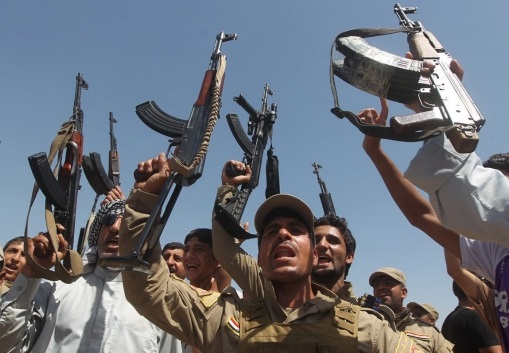 A jihadist movement, the Islamic State of Iraq and the Levant (ISIL), has just scored a stunning and sweeping victory by capturing Mosul, Iraq’s third city located in the north of the country. Their forces are proceeding southward towards Baghdad and have seized Tikrit, hometown of Saddam Hussein. The Iraqi army seems to have fallen apart, having also ceded Kirkuk to the Kurds. ISIL has also taken prisoner Turkish diplomats and truckers. It now controls effectively a large chunk of the north and west of Iraq as well as a contiguous zone in the northeast corner of Syria. Commentators have labeled this trans-border zone Jihadistan. ISIL seeks to reestablish a caliphate in as large an area as possible, one based on a particularly strict version of sharia law.
A jihadist movement, the Islamic State of Iraq and the Levant (ISIL), has just scored a stunning and sweeping victory by capturing Mosul, Iraq’s third city located in the north of the country. Their forces are proceeding southward towards Baghdad and have seized Tikrit, hometown of Saddam Hussein. The Iraqi army seems to have fallen apart, having also ceded Kirkuk to the Kurds. ISIL has also taken prisoner Turkish diplomats and truckers. It now controls effectively a large chunk of the north and west of Iraq as well as a contiguous zone in the northeast corner of Syria. Commentators have labeled this trans-border zone Jihadistan. ISIL seeks to reestablish a caliphate in as large an area as possible, one based on a particularly strict version of sharia law.
The shock and fear that the successes of this movement have inspired may lead to major geopolitical realignments in the Middle East. Geopolitics is an arena of frequent surprises, in which known antagonists suddenly reconcile themselves and transform their relation into one of what the French call frères ennemis (friendly enemies). The most famous instance in the last half-century was the trip of Richard Nixon to China to meet with Mao Zedong, a trip that fundamentally revised the alignments within the modern world-system and has underlain the China-United States relationship ever since.
The world media have long emphasized the deep hostility between Saudi Arabia and Iran. Any reconciliation would therefore appear unlikely. But since there seem to have been secret meetings between the two countries in recent months, one must wonder if such a surprise geopolitical reversal is not in the offing.
Whenever such turnarounds occur, the question to ask is what the two sides get out of it. There must be certain common interests that outweigh the known bases of hostility. Let us start by putting aside one claim of analysts to explain the antagonism. This is the fact that Iran’s government is controlled by Shia imams and that of Saudi Arabia is controlled by a Sunni monarchy. This is of course true. But we should remember that up to 1979, Iran (under the Shah) and Saudi Arabia (under the same Sunni monarchy) were close geopolitical allies, and worked together within the Organization of Petroleum Exporting Countries (OPEC) on all issues related to the price of oil — a central economic concern for both countries. After 1979, Iran changed its politics and the public antagonism between the two commenced, but only then.
The fundamental issue that has pushed the public struggle between Saudi Arabia and Iran has been a competition for the dominant geopolitical role in the region. What could change this now is precisely the rise of ISIL, which represents a grave menace for both states. The one common interest of the regimes in Saudi Arabia and Iran is their need for relative stability within their states and within the region as a whole.
Of course both regimes are beset by internal divisions between more “liberalizing” urban middle-class elements and advocates of a strict conservative version of traditional Islam. But the threat that ISIL represents to both groups in both countries could lead them to favor quieting down other kinds of struggles. There are presently such struggles between various non-ISIL forces going on in Syria, Lebanon, Iraq, Bahrain, Yemen and elsewhere.
There are in addition other elements pushing towards this kind of reconciliation. Both regimes share a dismay about the uncertain but continuing interventions of the United States and European countries in their region. The Saudis have lost faith in the reliability of past alliances, and are coming closer to the Iranian view that the western world should allow the regional forces to settle their own differences. Both regimes are also unhappy about the constant and somewhat unpredictable role of Qatar in the region. And both regimes are unhappy at the inability to move forward with the creation of a meaningful Palestinian state. Both regimes cast a wary eye on the secular military regime now established in Egypt. And finally both regimes want to see some kind of political resolution of the conflicts in Afghanistan.
This is a long list of common interests. In short, they have more in common than outside analysts often credit. Furthermore, should they come to a historic accord, the new arrangement might attract a great deal of support — first of all from Turkey, but then as well from the Kurds, from the Maghreb, from Jordan, from Pakistan and India, from Russia and China, and even from within Afghanistan. Of course, this is speculation, but it is not idle speculation. The reality is that the regimes in both Saudi Arabia and Iran are worried about their survival amidst the growing disintegration of the Middle East. Continuing on their present course is not likely to help them survive. They may be thinking that it is time to change course.
